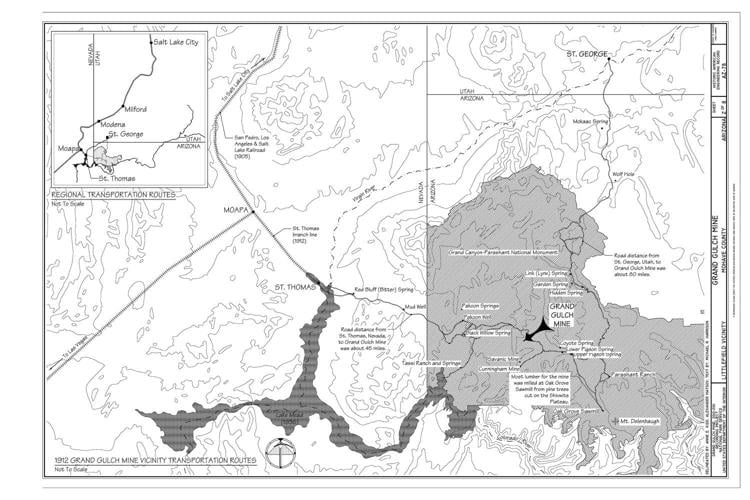One of the best producers of copper in Northern Arizona was the Grand Gulch Mine, located on the edge of the Grand Wash Cliffs in the western part of the Arizona Strip.
This remote desert region north of the Grand Canyon, while within Arizona, has historically served as an extension of Mormon settlement in southern Utah.
A member of the Shivwits band of Paiute Indians told Samuel L. Adams, Joe Cunningham and Richard Bentley about a vein of rich copper ore running as high as fifty percent. In 1874, they journeyed in from St. George, Utah, to northwestern Arizona to work what would become known as the Adams Lode, or Grand Gulch Mine, in the Bentley Mining District.
Adams, a local blacksmith, took the greatest initiative in registering the claim, spending $100 a year on labor and materials with which to improve the mine as stipulated by federal law.
Pigeon Spring, located 8 miles east of the mine, supplied the camp with water. Lumber from pine trees cut on the Shivwits Plateau was milled at Oak Grove and shipped to the mine.
A 40-pound mass of copper impregnated with silver from the mine was given to Brigham Young, president of the LDS church.
A stone and adobe-brick smelter was erected in 1878. It was overseen by the Grand Gulch Copper Mining Co., which incorporated at St. George by Adams and Bentley on September 15, 1874.
By 1881, several tons of copper bullion had been extracted from the mine. The ore included azurite, malachite and chalcocite. There were also small amounts of silver, some of which amounted to 16 ounces per ton.
Ore was shipped from the mine to St. George and then on to Milford, Utah, the nearest railhead. It was then taken by the Utah Central Railroad to Salt Lake City. There it was sold to Pope, Cole & Co., a Baltimore copper refiner, for 14.5 cents a pound.
Rising shipping expenses caused the mine to close in 1882. As a result, the 21 acres of patented land then known as the Adams Mine was sold for delinquent taxes and redeemed by C.C. Bradley.
The Jennings brothers, who lived in Salt Lake City, acquired the majority of the mine’s shares, and reopened in 1899.
Several structures, including a powder house, blacksmith shop and bunkhouses were built on-site during the next decade.
In 1905, a 40-mile road was created to reduce haulage costs to the St. Thomas, Nevada, railroad.
Freighting outfits included up to 10 horses, hauling between 8 to 12 tons of ore valued at $13.50 per ton.
Nearby mining operations included the Savanic Mine, or Bronzell Mine, operated by Harry Gentry and Levi Syphus of St. Thomas. Nevada, which produced more than $2 million pounds of copper between 1906 and 1919.
The Grand Gulch Mine averaged 17 employees, gradually increasing to 75 by 1916. Most of the laborers came from St. George, Utah.
The principal shaft encompassing several levels went 500 feet in depth and produced 4.5 million pounds of copper during its operation. It closed in 1919 due to a fall in the price of copper, coupled with a depletion of the mine’s ore reserves. Subsequent attempts to work the ore dumps proved marginal, with ore hauled for processing to Hurricane, Utah.
A Fairbanks-Morse truck was used to haul ore. However, it later proved inadequate because its wheels would sink into the sand.
According to the Bureau of Mines, the mine shipped 15,701 tons of ore between 1901 and 1951, which included 6.6 million pounds of copper, along with 24,349 ounces of silver and 715 pounds of lead.
Though in private ownership today, the mine encompasses part of the Grand Canyon-Parashant National Monument, which is overseen by the Bureau of Land Management and the National Park Service.





